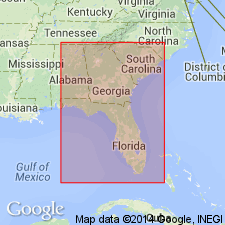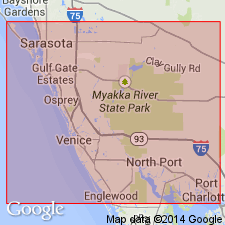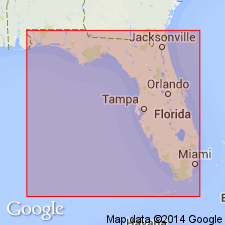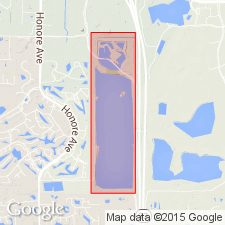
- Usage in publication:
-
- Sarasota Member
- Modifications:
-
- Named
- Dominant lithology:
-
- Clay
- AAPG geologic province:
-
- South Florida province
Summary:
Uppermost member of Hawthorn Formation, which has previously remained unnamed, is here referred to as Sarasota Member (Unit 11 of Petuch, 1982: Proc. Acad. Nat. Sci, Philadelphia 134, p. 12-30). Typically a yellow-tan calcareous clay. Contains large percentage of phosphorite pebbles and granules and abundant phosphatized bone fragments, mainly from large marine mammals. Shark teeth common. Differs from lower members of Hawthorn in that they contain no macrofossils. In addition to type section, where only 1 m is exposed, unit is also exposed at depth of 10 to 20 m in several small quarries along I-75 south of Venice, Sarasota Co. Thickness from core data estimated at over 20 m. Unconformably underlies early Pliocene Buckingham Formation. Correlated on the basis of fossils with Eastover Formation of MD and VA. Age is late Tortonian and early Messinian.
Source: GNU records (USGS DDS-6; Reston GNULEX).

- Usage in publication:
-
- Sarasota
- Modifications:
-
- Not used
- AAPG geologic province:
-
- Florida platform
Summary:
The basal layer of the fossiliferous units found at APAC and Quality Aggregates shell pits in Sarasota Co., FL, was originally referred to as Bed 11 by Petuch (1982) and placed along with other Pinecrest units in the Buckingham (Petuch, 1987). In 1988, Petuch formally named the bed the Sarasota Member of the Hawthorn Formation, removing it from the Tamiami Formation. The unit remains Bed 11 in this report and the author discusses how it differs from both the overlying Pinecrest Beds and the underlying Hawthorn Group. Petuch assigned the bed to the upper Miocene. This author gives it an early Pliocene age based on stratigraphic position above the Hawthorn-Tamiami contact and index fossils. The Bed correlates faunistically to Hunter's Murdock Station Member and lithologically to Missimer's Fort Myers clay member, both of the Tamiami Formation.
Source: GNU records (USGS DDS-6; Reston GNULEX).

- Usage in publication:
-
- Sarasota Formation
- Modifications:
-
- Revised
- AAPG geologic province:
-
- Florida platform
Summary:
Tamiami Group (usage of DuBar, in press) is divided into the lower Murdock Station Formation and the upper Sarasota Formation. Sarasota is further subdivided into Myakka, Buckingham Limestone, Ochopee Limestone, Forty Mile Bend Members and a coral/mollusk biohermal facies. Unit is named for shelly quartz sands (Myakka Member) exposed in pits east of Sarasota, FL.
Source: GNU records (USGS DDS-6; Reston GNULEX).

- Usage in publication:
-
- Sarasota Member
- Modifications:
-
- Not used
- AAPG geologic province:
-
- Florida platform
Summary:
Author states that it is not clear how Petuch's (1988) Sarasota Member of the Hawthorn Formation differs faunistically from Hunter's (1968) Murdock Station Member of the Tamiami Formation. On the basis of the species Petuch (1982) listed in Unit 11 (now designated Sarasota Member), the unit might be assigned an early Pliocene age. Because of uncertainties in the relationship between these units, author continues to refer strata to the Tamiami, though Vokes (1988) preferred to call them Pinecrest beds.
Source: GNU records (USGS DDS-6; Reston GNULEX).

- Usage in publication:
-
- Sarasota unit
- Modifications:
-
- Overview
- AAPG geologic province:
-
- Florida platform
Summary:
Though Petuch formally named the Sarasota in 1988 as a member of the Hawthorn, he refers to it in this report as "unit." It is here correlated with the Buckingham and Tamiami Formations and appears in Fig. 1 as Pliocene in age. Correlations in this report are based on extinction events. All three of the above contain the Kissimmean faunas.
Source: GNU records (USGS DDS-6; Reston GNULEX).
For more information, please contact Nancy Stamm, Geologic Names Committee Secretary.
Asterisk (*) indicates published by U.S. Geological Survey authors.
"No current usage" (†) implies that a name has been abandoned or has fallen into disuse. Former usage and, if known, replacement name given in parentheses ( ).
Slash (/) indicates name conflicts with nomenclatural guidelines (CSN, 1933; ACSN, 1961, 1970; NACSN, 1983, 2005, 2021). May be explained within brackets ([ ]).

